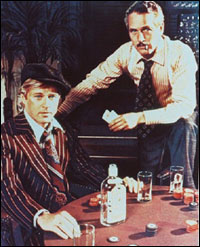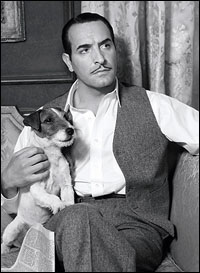
*
Not having seen George Roy Hill's The Sting [Universal] since its release almost 40 years ago, I am pleased to find it as enjoyable today as upon first viewing. What's more, I am impressed by how well put together it is. The action slides along as if on well-greased wheels, gliding from scene to scene and delight to delight. The enjoyment starts not with the three star performances — each of which is delicious to watch — but with the carefully and delectably contrived scenario from Mr. Hill and scenarist David S. Ward. (Hill and Ward received Oscars for "The Sting," which also won Best Picture and an additional four.) It's a ballet of conmen conning, and the creators never make one false move. Or you could say that the whole film consists of false moves, which are carefully and cannily concealed by Hill and company.
All of this might not have worked precisely so well without the glistening performances by the cast. The project was a reunion of Hill with Paul Newman and Robert Redford, his stars from the 1969 "Butch Cassidy and the Sundance Kid." Newman and Redford were at the height of their fame in "The Sting" (and "Butch Cassidy" as well). Some under-40 viewers might consider the pair to be old-timers, from another era; one look at "The Sting" will show you why they were, both of them, outsized celebrities for more than a quarter century.
They are joined above the title by Robert Shaw, not a name of the same prominence but an actor clearly in their league. Shaw was by then a somewhat familiar presence on the big screen, his most prominent credit being Henry VIII in 1966 in "A Man for All Seasons" (which won him a featured Oscar nomination). He attracted attention as a Broadway playwright with The Man in the Glass Booth in 1968, and in 1970 made his one and only stab at a leading role in a Broadway musical — for one performance, plus previews — in Gantry. And he was pretty good, let me add, although the show wasn't. "The Sting" established Shaw as a major movie villain in 1973, which he followed with notably chilling performances as the insane hijacker in the 1974 "Taking of Pelham One Two Three" and as the driven shark hunter in the 1975 "Jaws."
 |
||
| Paul Newman and Robert Redford in "The Sting." |
"The Sting" looks wonderful on Blu-ray; all those design awards were truly merited. Bonus features include "The Art of The Sting," a three-part documentary featuring "A Perfect Script," "Making a Masterpiece" and "The Legacy." The Blu-ray hardcover book edition includes — along with the informative and colorful text — DVD and digital copies of the film.
Visit PlaybillStore.com to check out theatre-related DVDs for sale.
 |
||
| Cover art for "The Artist" |
The use of two memorable scenes from "Citizen Kane" — closely recreated — might seem questionable, as Welles made his film in 1941. As it turns out, they fit in wonderfully well. We get the emotion of the moments, which perfectly fit the action; but we are simultaneously flooded with warm feelings of nostalgia for "Kane," and Welles, and Hollywood altogether.
Director Michel Hazanavicius also has his music department borrow — as opposed to copy — Bernard Herrmann's Love Scene from Hitchcock's 1958 "Vertigo." Thus, we have a scene in "The Artist" — lovingly filched, as it is, from "A Star Is Born" — with an overlay of intense musical emotion suggesting the presence of Hitchcock, Jimmy Stewart, et all. Even viewers who don't know "Vertigo," and don't recognize the music, are likely to respond to the outside influences at play. All of this, many times over, makes "The Artist" the treat that it is.
But that's only part of the magic of "The Artist." That this Hollywood love story — born in Hollywood and mostly shot in Hollywood — should come from a French director and French star and French producer — seems unlikely; but everything about "The Artist" is unlikely, including its international success. If you do something well, I guess, the world comes to you.
 |
||
| Jean Dujardin in "The Artist." |
Director/writer Hazanavicius clearly knows precisely what he is doing, and manages to pull it off with elan. Dujardin, for his part, is irresistible. The pair have worked together before, notably on the French spy spoof series "OSS 117." Dujardin's costar here, Berenice Bejo, played his leading lady in "OSS 117: Cairo, Nest of Spies"; in the interim, she married director Hazanavicius. Bejo makes a delightful heroine as the spunky — or rather, peppy — Peppy Miller. The dog Uggie is an expert comedian, as are John Goodman as the studio head and James Cromwell as the loyal valet.
Bonus features include a blooper reel; a Q&A with the filmmakers and cast; and the featurettes "The Artist: The Making of an American Romance" and "Hollywood as a Character: The Locations of The Artist." This year's Oscar-winning "The Artist," all in all, is a grand and glorious black & white treat.
Visit PlaybillStore.com to check out theatre-related DVDs for sale.
 |
||
| Cover art for "The Gold Rush" |
We are given both the original 1925 silent along with the sound version Chaplin prepared in 1942. Criterion carefully describes the latter as Chaplin's authorized and favored version; one imagines that every element — even the placement of the films on the disc — was carefully dictated from on high.
Watching both versions again, together, I beg to differ. Sure, Charlie publicly proclaimed that 1942 displaced 1925; he produced and released it, and surely wasn't going to say it was inferior. But the 1925 version is "The Gold Rush" as Chaplin created it, in his prime; the later version is an older man — 52 at the time — trying to transform his classic for wartime audiences who would simply not pay to see a silent movie. The major new element was an extensive narration written and spoken by the director. The narration is amusing, needless to say, but I find it harmful. Here we have a gentle man with a British voice telling us what's funny, and what's supposed to be funny. Hey, it's perfect as is! The silent comedy and the titles let us discover what Chaplin's Lone Prospector is experiencing, at our own speed. With the narration, we inevitably wait to hear what Charlie has to say about it.
I also find the edits not especially helpful. The old version is rougher than the new; there are certain choices — edits, use of outtakes, the alteration of a tell-tale letter, and that narration — which change matters in a way that the middle-aged Chaplin apparently felt more proper. (This includes removal of the playfully romantic ending with Chaplin and Georgia Hale, who were clearly enjoying themselves.) The 1942 version is 16 minutes shorter than the original. While I respect the filmmaker's right to edit things out — including a subplot in which Jack, Georgia's boyfriend, taunts Charlie — I'd rather watch the film with those extra minutes, and without the narration. But the new Blu-ray allows you to chose for yourself.
The film profits from the standard Criterion treatment. The reconstructed 1925 version, restored in collaboration with the Cineteca di Bologna (and accompanied by the score Chaplin wrote for the 1942 version), looks wonderful. So does the 1942 version, naturally. Bonus features include new commentary by biographer Jeffrey Vance, plus three documentaries: "Presenting 'The Gold Rush,'" with Kevin Brownlow; "A Time of Innovations: Visual Effects in 'The Gold Rush'," with Craig Barron; and "Music by Charles Chaplin," from Timothy Brock (who adapted, expanded, and conducted the score for the 1925 version). "The Gold Rush" joins "Modern Times" and "The Great Dictator" in the Criterion Blu-ray catalogue. Now we can only wait, hopefully, for "City Lights" and "The Kid."
(Steven Suskin is author of the recently released Updated and Expanded Fourth Edition of "Show Tunes" as well as "The Sound of Broadway Music: A Book of Orchestrators and Orchestrations," "Second Act Trouble" and the "Opening Night on Broadway" books. He also pens Playbill.com's Book Shelf and On the Record columns. He can be reached at [email protected].)
*
Visit PlaybillStore.com to check out theatre-related DVDs for sale.










